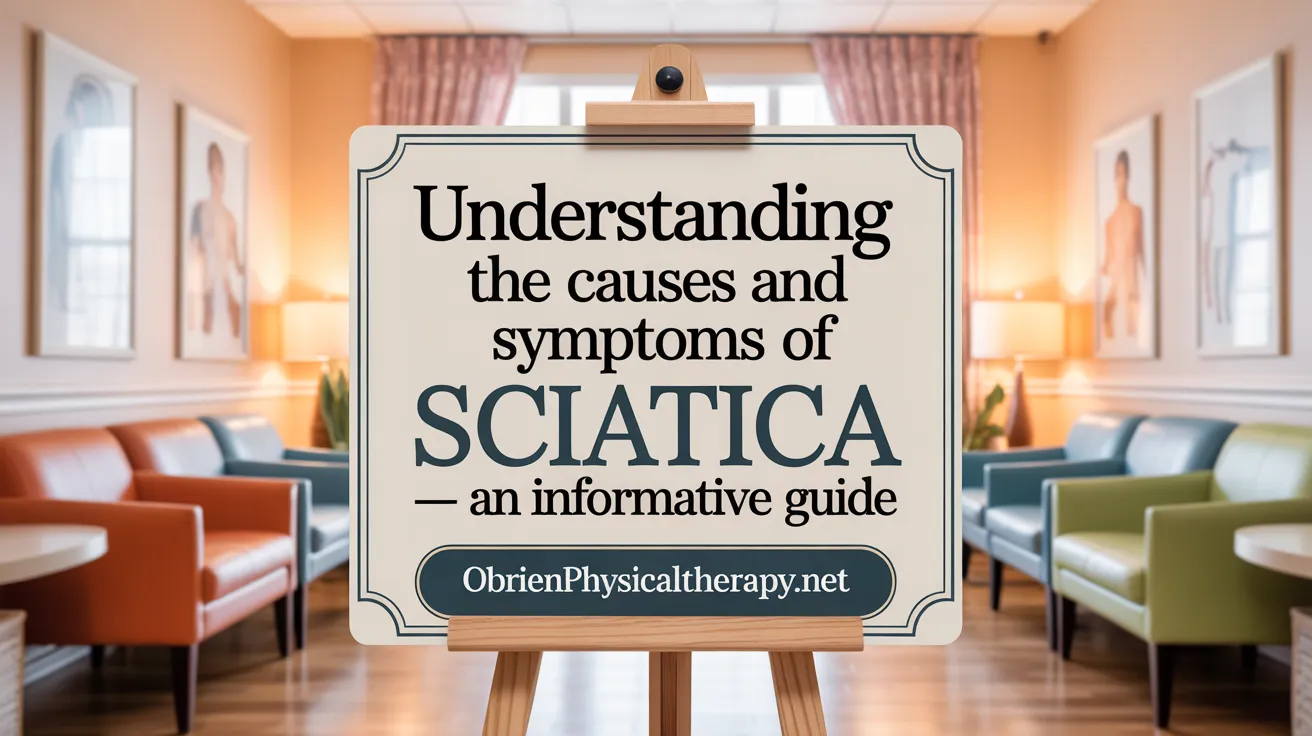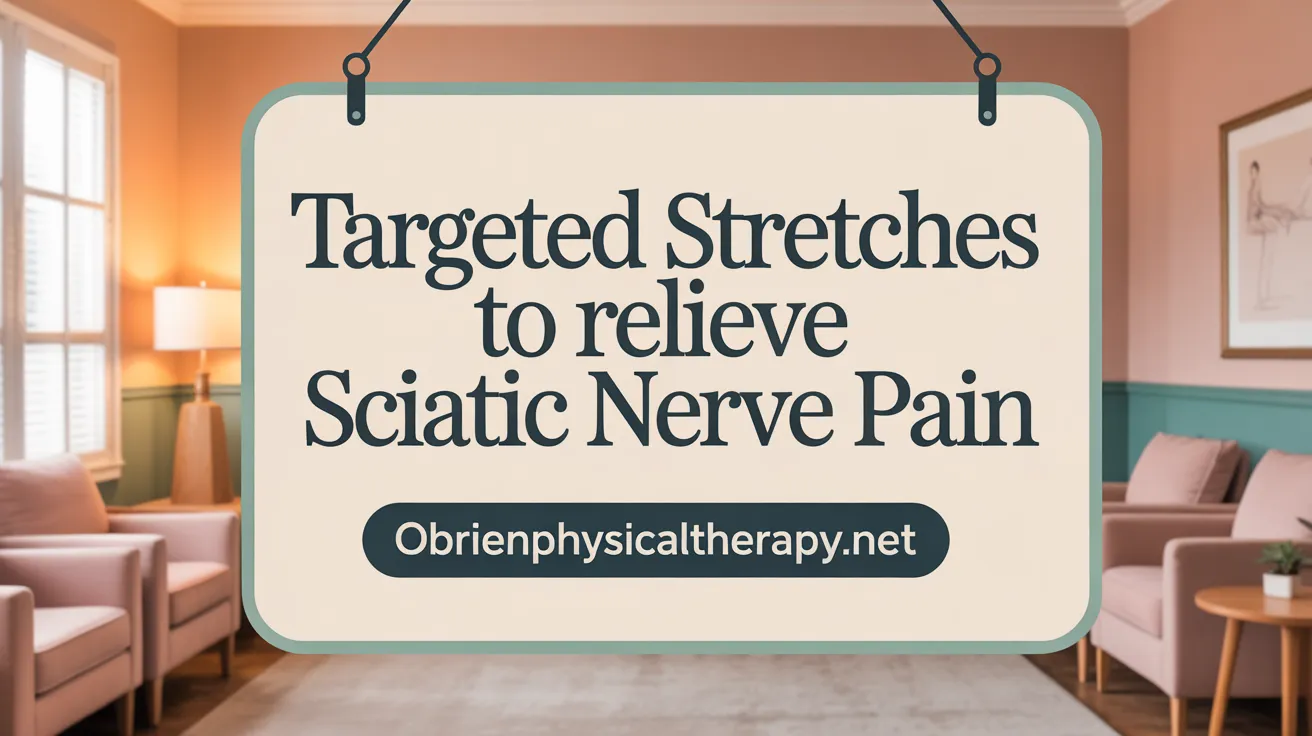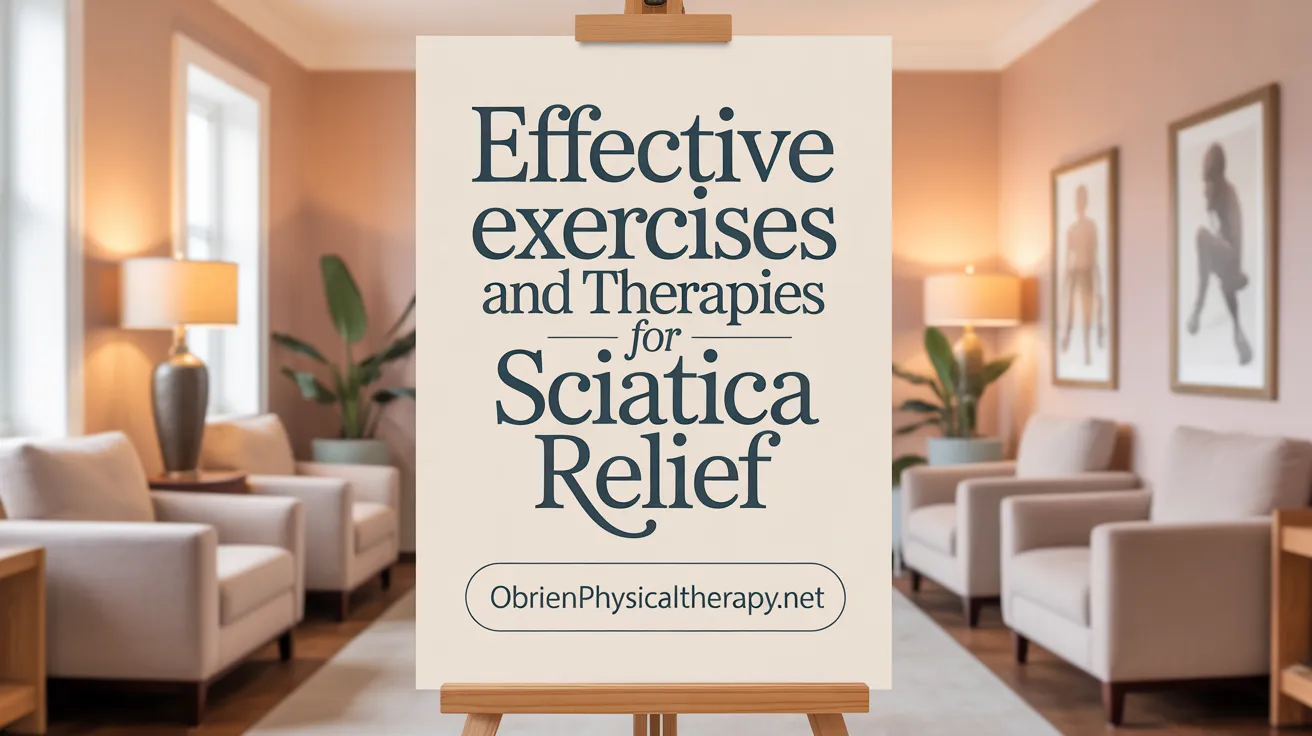Understanding Sciatica and Its Impact
Sciatica is a common and often debilitating condition characterized by pain radiating along the sciatic nerve pathway, affecting millions worldwide. Understanding its causes, symptoms, and effective non-surgical treatments is essential for managing this condition and improving quality of life. This article provides an in-depth look at sciatica, focusing on the role of targeted stretching and mobilization techniques as key components of treatment strategies.
What Causes Sciatica and What Are Its Common Symptoms?

What causes sciatica, and what are its common symptoms?
Sciatica occurs when the sciatic nerve becomes irritated, compressed, or inflamed, resulting in characteristic pain and discomfort. This nerve, the longest in the body, runs from the lower back through the hips and buttocks, extending down each leg. When affected, individuals often experience a sharp or burning sensation that radiates along the nerve’s pathway.
The most frequent causes of sciatica include mechanical issues such as herniated discs pressing on the nerve, spinal stenosis (narrowing of the spinal canal), degenerative disc disease, and spondylolisthesis, where one vertebra slips over another. Other causes involve injury, piriformis syndrome (where the piriformis muscle spasms and traps the nerve), tumors, and bone spurs. Inflammatory causes, like swelling due to injury, pregnancy, or infection, can also irritate the nerve.
Common symptoms of sciatica extend beyond pain. Many affected individuals report numbness or tingling sensations, muscle weakness in the leg or foot, and altered reflexes. In some cases, severe symptoms such as loss of bladder or bowel control may occur, signaling urgent medical attention.
Risk factors that increase the likelihood of developing sciatica include age-related degenerative changes, obesity, sedentary lifestyles, certain occupations involving heavy lifting or prolonged sitting, and medical conditions such as diabetes. Recognizing these factors and symptoms early is essential. Proper diagnosis by a healthcare provider is vital to determine the cause.
In most cases, conservative treatments like physical therapy, exercises, anti-inflammatory medications, and lifestyle adjustments can effectively manage symptoms. However, persistent or severe cases may necessitate surgical intervention. If symptoms worsen or include signs of nerve damage, seeking immediate medical care is crucial.
| Aspect | Details | Additional Info |
|---|---|---|
| Causes | Herniated discs, stenosis, injury, pregnancy, tumors | Mechanical or inflammatory origin |
| Symptoms | Pain, numbness, tingling, muscle weakness, altered reflexes | Varies in severity and location |
| Risk Factors | Age, obesity, sitting, heavy lifting, diabetes | Lifestyle and health-related factors |
| When to Seek Help | Severe pain, weakness, bladder/bowel problems | Urgent signs indicating possible cauda equina syndrome |
Understanding the causes and symptoms of sciatica helps in seeking timely treatment and managing the condition effectively.
Non-Surgical Treatment Options for Sciatica: An Overview

What are the non-surgical treatment options available for sciatica?
Managing sciatica without surgery involves a combination of approaches focused on reducing pain, improving mobility, and addressing underlying issues. Physical therapy plays a central role, providing targeted exercises that stretch and strengthen the lower back, hips, and core muscles. These exercises, such as the Glute Bridge, Knee-to-Chest Stretch, and Bird-Dog, help increase flexibility, improve posture, and support spinal health.
In addition to exercise, heat and cold therapy are commonly used to reduce inflammation and muscle tension. Applying ice packs can diminish swelling, while heat therapy promotes blood flow and relaxes tense muscles, aiding the healing process.
Medications offer another layer of relief. Nonsteroidal anti-inflammatory drugs (NSAIDs) alleviate pain and inflammation, muscle relaxants ease muscle spasms, and short-term use of opioid analgesics can be prescribed for severe pain. For persistent inflammation, epidural steroid injections or nerve root blocks may be administered to reduce nerve irritation locally.
Complementary treatments such as chiropractic adjustments, massage, and acupuncture can also be beneficial. These therapies aim to relieve muscle tension, improve nerve mobility, and promote circulation.
Most cases of sciatica respond well to these conservative strategies, often resolving within a few weeks. Early intervention with physical therapy and lifestyle modifications often prevents progression to chronic pain and reduces the likelihood of requiring surgical intervention.
How Targeted Stretching Eases Sciatic Pain
 Targeted stretching plays a vital role in alleviating sciatica by reducing muscle tightness and enhancing flexibility in critical areas such as the lower back, hips, and legs. When muscles like the piriformis, hamstrings, and lower back become tense, they can press against or irritate the sciatic nerve, causing pain, numbness, or tingling. Gentle stretching exercises address these muscles directly, helping to loosen their tightness and decrease nerve compression.
Targeted stretching plays a vital role in alleviating sciatica by reducing muscle tightness and enhancing flexibility in critical areas such as the lower back, hips, and legs. When muscles like the piriformis, hamstrings, and lower back become tense, they can press against or irritate the sciatic nerve, causing pain, numbness, or tingling. Gentle stretching exercises address these muscles directly, helping to loosen their tightness and decrease nerve compression.
Some of the most effective stretches for sciatic relief include the Knee-to-Chest stretch, Piriformis stretch, and Hamstring stretches. The Knee-to-Chest stretch involves lying on your back and pulling one knee toward your chest to stretch the lower back and glutes. The Piriformis stretch may be done sitting or lying down, aiming to relax this small muscle that can spasm and trap the nerve. The Hamstring stretch targets the back of the thighs, reducing tension that can pull on the pelvis and lower back.
In addition to stretching, mobilization techniques—often guided by physical therapists—can help increase the mobility of the spinal joints and sciatic nerve itself. These involve gentle movements that promote nerve gliding, decreasing mechanosensitivity and inflammation that contribute to pain.
It is crucial that stretching and mobilization are performed gradually and safely. Overstretching or forcing movements can exacerbate symptoms, so exercises should be tailored to individual tolerance levels. Regular practice of these gentle stretches, ideally at least twice a week, can lead to measurable improvements.
The benefits of targeted stretching extend beyond immediate pain relief. Long-term, these exercises improve overall flexibility, reduce muscle spasms, and prevent future flare-ups. They contribute to better posture, spinal health, and mobility, helping individuals manage symptoms effectively while avoiding the risks associated with overexertion.
For persistent or severe symptoms, consulting a healthcare provider or physical therapist ensures that stretching routines are appropriate and safe. When integrated into a comprehensive treatment plan, targeted stretching can significantly reduce sciatic pain and improve quality of life.
Effective Exercises and Physical Therapy Techniques for Sciatica

What types of exercises and physical therapy methods are effective in alleviating sciatica symptoms?
Managing sciatic nerve pain often involves a combination of gentle stretching, strengthening exercises, nerve mobilization, and manual therapy. These approaches aim to relieve nerve pressure, improve mobility, and support spinal health.
Stretching exercises like Child's Pose, Cobra Stretch, and Lying Knee-to-Chest are effective in reducing muscle tension around the lower back and hips. These stretches help loosen tight muscles and lessen pressure on the sciatic nerve. The Child’s Pose gently relaxes the lower back and hips, while the Cobra Stretch increases spinal flexibility. The Knee-to-Chest stretch is particularly helpful in elongating the lower back and decompressing the nerve.
Strengthening routines focus on stabilizing the spine and boosting core support. Exercises such as the Glute Bridge, Clamshell, and Bird-Dog are commonly prescribed. The Glute Bridge strengthens the glutes and lower back muscles, providing support to the pelvis. Clamshell exercises target the hip abductors, improving hip stability, whereas Bird-Dogs enhance core strength and balance.
In addition, nerve mobilization techniques, often referred to as nerve flossing, involve specific movements to improve the mobility of the sciatic nerve. These techniques help decrease nerve mechanosensitivity and facilitate better movement along the nerve pathway.
Incorporating low-impact aerobic activities like walking, swimming, or cycling can promote circulation and enhance recovery without aggravating symptoms. These activities maintain gentle movement and help reduce overall pain and stiffness.
Manual therapy and modality treatments are also valuable components of a comprehensive treatment plan. Techniques such as deep tissue massage, joint mobilization, or soft tissue manipulation can alleviate muscular tension and improve joint function. Modalities like ultrasound, electrical stimulation (TENS), and infrared therapy may further support pain relief and tissue healing.
Combining these exercises and therapies under professional guidance can significantly improve symptoms and help prevent future episodes of sciatica.
Understanding Nerve and Spinal Mobilization in Sciatica Treatment
Principles of nerve mobilization and spinal mobilization
Nerve mobilization, also known as neural mobilization, involves carefully stretching and moving the sciatic nerve to improve its ability to glide smoothly within the surrounding tissues. This technique aims to reduce adhesions or restrictions that can cause irritation or compression of the nerve. Spinal mobilization, on the other hand, focuses on restoring normal movement and alignment to the vertebrae. By improving spinal mobility, it helps decrease pressure on nerve roots that may be contributing to sciatic pain.
How these techniques improve nerve glide and spinal movement
These methods enhance the flexibility and movement of the nerves and joints, helping to alleviate the tension and irritation that cause pain. Nerve mobilization promotes better nerve glide, making it easier for the nerve to move comfortably during daily activities. Spinal mobilization improves joint function, which can relieve pressure points in the lower back and reduce nerve compression. Together, these techniques can improve the overall mobility of the lower back and legs.
Benefits in reducing pain and enhancing function
Patients often experience a reduction in sciatic pain, numbness, and tingling after undergoing nerve and spinal mobilization. Additionally, these therapies can improve range of motion, strengthen supporting muscles, and promote healing of soft tissues. Many individuals report better mobility and less discomfort, which supports their ability to perform daily tasks more easily.
Evidence regarding effectiveness and safety
Research studies and systematic reviews indicate that incorporating nerve and spinal mobilization techniques into conservative treatment plans can lead to short-term improvements in pain and disability. These methods are generally well-tolerated and considered safe when performed by trained healthcare professionals. However, the strength of the evidence varies, and more high-quality research is needed to confirm how long-lasting these benefits are and to better understand their mechanisms.
How do nerve mobilization and spinal mobilization work to improve sciatica symptoms, and how effective are they?
Nerve mobilization works by gently stretching and gliding the sciatic nerve to reduce adhesions and improve its function, lessening irritation. Spinal mobilization restores movement to the vertebrae, decreasing pressure on nerve roots. Both techniques can promote soft tissue healing, stimulate nervous system functions, and improve nervous system flexibility and adaptability. Various studies support their use, showing moderate evidence of short-term pain relief and improved mobility. While generally safe, ongoing research is necessary to determine their long-term effectiveness and optimal application parameters.
The Role of Physical Therapy and Non-Invasive Interventions
What roles do physical therapy and other non-invasive interventions play in the treatment of sciatica?
Physical therapy and non-invasive treatments are often the first line of management for sciatica, especially in cases of mild to moderate symptoms. These approaches are designed to reduce nerve pressure, alleviate pain, and restore mobility without surgery.
A personalized treatment plan is essential, as every individual’s condition is unique. Therapists focus on targeted exercises that stretch and strengthen the muscles supporting the lower back and pelvis. For example, gentle stretching routines like the Knee-to-Chest Stretch or Cobra Stretch help relax the sciatic nerve and improve flexibility.
Manual therapy techniques, such as soft tissue manipulation and joint mobilization, assist in reducing muscular tension, improving spinal mobility, and easing nerve compression. Nerve mobilization exercises, or nerve gliding, can help enhance nerve mobility and decrease sensitivity, which often relieves sciatic pain.
Patient education plays a vital role in managing sciatica. Healthcare providers teach proper posture, body mechanics, and ergonomic adjustments to prevent aggravation of symptoms. Simple modifications at work, during lifting, or daily activities can significantly improve long-term outcomes.
Furthermore, modalities like Transcutaneous Electrical Nerve Stimulation (TENS) or electrical stimulation can provide temporary pain relief by interfering with nerve signals. These tools complement active therapy by reducing discomfort and facilitating movement.
Preventing future episodes involves ongoing self-care, including regular stretching, strength-building exercises, and maintaining good posture. Applying these strategies thoughtfully minimizes the likelihood of recurrent nerve irritation and promotes overall spinal health.
In summary, physical therapy and other non-invasive methods form an effective, safe approach to managing sciatic symptoms, reducing reliance on medications, and avoiding unnecessary surgeries. They empower individuals with the knowledge and tools needed for long-term relief and improved quality of life.
Self-Care Strategies for Managing Sciatica and Improving Mobility
What self-care techniques can individuals use to manage sciatica and improve mobility?
Managing sciatic nerve pain often begins with simple, at-home self-care methods aimed at reducing discomfort and promoting healing. Application of cold and heat therapies are two of the most effective initial steps. In the first 48 to 72 hours after symptoms begin, using ice packs or ice massage can help decrease inflammation and numb pain. After this period, switching to heat therapy—such as warm packs, heating pads, or warm baths—helps relax tense muscles, improve circulation, and alleviate persistent discomfort.
Besides temperature treatments, targeted stretching exercises can make a significant difference. Gentle stretches like the Knee-to-Chest, Piriformis stretch, and Hamstring stretches help release nerve pressure and increase flexibility. Incorporating low-impact aerobic activities, such as walking, swimming, or stationary cycling, also supports overall mobility, strengthens supporting muscles, and reduces stiffness.
Maintaining good posture is crucial. Simple ergonomic adjustments, like supporting the lower back while sitting, avoiding prolonged periods of inactivity, and lifting objects properly, can prevent aggravation of symptoms. Consistency in applying these self-care measures is vital for long-term relief.
Using over-the-counter pain relievers may provide temporary comfort, but they should complement other strategies, not replace them. Regularly practicing these habits can help reduce sciatic pain, enhance mobility, and decrease the chance of future episodes. Always consult healthcare providers or physical therapists if pain worsens or persists beyond a few weeks, to tailor an individualized treatment plan.
Advanced Techniques: Force-Based Cox Technic Flexion Distraction Decompression
What is CTFDD spinal manipulation?
Force-based Cox Technic Flexion Distraction Decompression (CTFDD) is an advanced spinal treatment used specifically for sciatic nerve issues. It involves applying precise, controlled forces to gently stretch and mobilize the lumbar spine. This technique aims to reduce nerve compression, improve spinal flexibility, and promote healing.
How do the mechanics of flexion and distraction work?
During CTFDD, the therapist carefully combines flexion (bending the spine forward) with distraction (gentle pulling apart of the vertebrae). These movements are performed using measured forces, often monitored through specialized equipment. The goal is to decompress the nerve roots and restore normal nerve mobility, which can help alleviate sciatic pain.
Treatment protocols and monitoring
The procedure typically follows protocols such as Protocol 1 and Protocol 2, which involve different cycles of force application. These include cycles of equal cephalad (toward the head) hand force and caudal (downward) force along the long axis of the spine. In Protocol 2, additional movements like lateral flexion and circumduction can be incorporated.
During treatment, therapists collect objective data, such as force and movement graphs, to monitor progress and ensure that forces remain within safe, effective ranges. This precise measurement helps tailor the therapy to each patient's needs.
Clinical outcomes and benefits
Patients undergoing force-based CTFDD have shown promising results. Many experience a reduction in sciatic pain, improved motor functions like dorsiflexion, and increased lumbar mobility. Follow-up assessments often demonstrate normalized neurological function and decreased nerve mechanosensitivity, indicating less nerve irritation.
How does it integrate with other therapies?
CTFDD is frequently combined with other modalities like electrical muscle stimulation (EMS), infrared light therapy (ILT), and targeted home exercises. Together, these approaches can enhance pain relief, strengthen supporting muscles, and increase flexibility. The synergy of manual and modalities-based treatments offers a comprehensive pathway to recovery.
This innovative approach represents a promising non-surgical option for sciatic nerve pain, adding to the growing repertoire of evidence-based therapies aimed at safe, effective relief.
| Aspect | Description | Additional Details |
|---|---|---|
| Technique | Flexion and distraction forces applied to lumbar spine | Measured forces with real-time monitoring |
| Protocols | Protocol 1 and Protocol 2 with force cycles | Incorporate flexion, lateral flexion, circumduction |
| Outcomes | Pain reduction, improved mobility, motor function | Assessed via clinical tests and graph data |
| Integration | Combines with EMS, ILT, exercises | Enhances overall treatment efficacy |
This comprehensive approach highlights how precise mechanical interventions can significantly aid in the management of sciatica, offering hope to many patients resistant to conservative measures.
Key Targeted Stretches to Alleviate Sciatic Nerve Pain
How to Stretch Safely to Relieve Sciatic Pain
Targeted stretching can help decrease pressure on the sciatic nerve, soothe muscle tension, and improve overall mobility. Here are some of the most recommended exercises:
Knee-to-Chest Stretch
Lie on your back with legs extended. Bend one knee and gently pull it toward your chest, holding for 20-30 seconds. Switch sides. This stretch directly targets the lower back and glutes, helping to loosen tight muscles.
Piriformis Stretch
Lie on your back or sit with crossed legs. Gently pull the knee of your affected side across your body towards the opposite shoulder, feeling tension in the buttock region. Hold for 20 seconds and repeat. This stretch can help relax the piriformis muscle, which sometimes irritates the sciatic nerve.
Hamstring Stretch
While standing or sitting, extend one leg and lean forward from the hips, reaching toward your toes. Keep your back straight and avoid overstretching. This technique relaxes the hamstring muscles, reducing tension on the sciatic nerve.
Pelvic Tilt
Lie on your back with knees bent and feet flat on the floor. Tighten your abdominal muscles to flatten your lower back against the floor, tilting your pelvis upward. Hold for a few seconds and release. This helps strengthen lower back muscles and improves spinal alignment.
Step-by-Step Guidance for Safe Practice
- Always warm up with light activity before stretching.
- Perform each stretch gently; avoid forcing the movement.
- Hold each stretch for at least 20 seconds, breathing normally.
- Repeat each stretch 8-10 times, at least twice a week.
- Stop immediately if you experience increased pain or discomfort.
Why Proper Stretching Matters
Consistent, gentle stretching can increase flexibility, reduce nerve pressure, and prevent future flare-ups. It is crucial to avoid aggressive movements or heavy stretches during acute pain episodes, as these can worsen symptoms.
Final Notes
Always consult your healthcare provider before starting a new stretching routine, especially if symptoms worsen or if you have other underlying health conditions. Proper technique and cautious progression are vital to achieving relief without risking injury.
Posture, Body Mechanics, and Lifestyle Modifications for Sciatica Management

Importance of spinal alignment and correct posture
Maintaining proper spinal alignment and good posture is essential in managing sciatic nerve pain. Proper alignment minimizes unnecessary pressure on the sciatic nerve, reducing the risk of flare-ups.
Ergonomic advice for work and daily activities
Adjusting your workspace and daily routines can significantly impact sciatic health. Use ergonomic chairs, keep screens at eye level, and avoid prolonged sitting or awkward positions. Regular breaks and stretches during work hours help keep muscles relaxed.
Safe lifting techniques
Lifting heavy objects improperly can strain your lower back and worsen sciatic symptoms. Always bend at your hips and knees, keep the back straight, and lift with your legs. Avoid twisting your body while lifting or carrying loads.
Avoiding aggravating movements such as heavy lifting and twisting
During episodes of sciatic pain, avoid activities that involve heavy lifting, twisting, or sudden movements. These can exacerbate nerve compression or muscle strain, delaying recovery.
Role of education in preventing flare-ups
Educating yourself about proper body mechanics, posture, and activity modification can prevent future incidents. A healthcare provider or physical therapist can provide tailored advice, helping you adopt habits that support spinal health.
Adopting these lifestyle strategies can support ongoing management of sciatica, prevent aggravations, and promote quicker recovery. Consistent attention to posture and body mechanics forms the foundation for long-term nerve health and pain relief.
Integrating Manual Therapy and Modalities in Sciatica Care
How do manual therapy techniques help with sciatica?
Manual therapy includes methods like deep tissue massage, joint manipulation, and nerve mobilization—techniques used by trained healthcare providers to improve mobility and reduce tension around the sciatic nerve.
Deep tissue massage targets tight muscles and soft tissues that may be compressing the nerve. Joint manipulation, including spinal mobilization, helps restore proper joint movement, easing pressure on nerve roots. Nerve mobilization techniques, or nerve gliding exercises, increase the nerve's flexibility and reduce sensitivity, which can lessen pain and improve conditions.
These approaches help alleviate muscle tension, improve spinal mobility, and can directly target the factors causing nerve compression.
What role do modalities like heat, cold, and electrical stimulation play?
Therapies like heat therapy relax muscles and improve circulation, providing temporary pain relief. Cold therapy can reduce inflammation and numb painful areas, especially in the acute phase. Electrical stimulation devices, such as TENS (Transcutaneous Electrical Nerve Stimulation), modulate nerve activity and help reduce pain perception.
Using these modalities in combination with manual therapy allows a comprehensive approach, addressing both symptom management and underlying mechanical issues.
How do combination therapies enhance recovery?
Combining manual therapy and modalities offers a synergistic effect. Manual techniques can prepare the tissues for movement, while modalities can reduce pain and swelling, enabling more effective physical therapy exercises.
This integrated approach can accelerate healing, improve function, and decrease the likelihood of recurring episodes. It provides a personalized treatment plan tailored to the patient’s specific condition and response.
How important is patient responsiveness and individualization?
Every person with sciatica responds differently to treatments. Tailoring therapies based on individual symptoms, response to initial treatments, and preferences enhances outcomes.
Practitioners often monitor patient feedback during therapy, adjusting techniques and modalities to optimize comfort and effectiveness.
In summary, combining manual therapy techniques with modalities like heat, cold, and electrical stimulation forms a comprehensive approach that addresses pain, improves mobility, and supports recovery in sciatica management.
Promoting Recovery Through Targeted Stretching and Mobilization
Targeted stretching and mobilization techniques represent powerful, non-invasive approaches for relieving sciatica symptoms and improving functional mobility. Through tailored physical therapy programs, including nerve and spinal mobilization, strengthening exercises, and patient education, individuals can achieve significant pain reduction and enhanced quality of life. Combining these methods with self-care practices and, when appropriate, advanced therapies like force-based spinal manipulation, offers a comprehensive strategy for managing sciatica without surgery. Continued research and personalized treatment remain vital to optimizing outcomes and supporting long-term spinal health.
References
- Stretches and Exercises to Ease Sciatica Pain, from a PT
- Sciatica: Gentle stretches to help relieve pain and improve ...
- The effects of self-mobilization techniques for the sciatic ...
- 9 Effective Treatment Options for Sciatica Pain Relief
- A Guide to Managing Sciatica: Stretches, Exercises, and ...
- Spinal manipulation and mobilization forces delivered ...
- Stretches for Sciatica Pain Relief
- 9 Sciatica Stretches to Ease Nerve Pain
